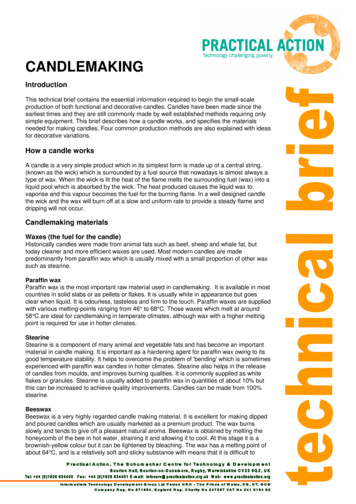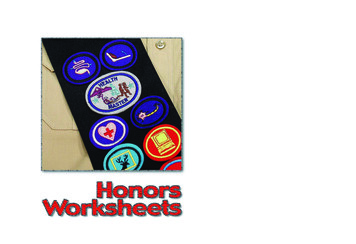
Transcription
CANDLEMAKINGIntroductionThis technical brief contains the essential information required to begin the small-scaleproduction of both functional and decorative candles. Candles have been made since theearliest times and they are still commonly made by well established methods requiring onlysimple equipment. This brief describes how a candle works, and specifies the materialsneeded for making candles. Four common production methods are also explained with ideasfor decorative variations.How a candle worksA candle is a very simple product which in its simplest form is made up of a central string,(known as the wick) which is surrounded by a fuel source that nowadays is almost always atype of wax. When the wick is lit the heat of the flame melts the surrounding fuel (wax) into aliquid pool which is absorbed by the wick. The heat produced causes the liquid wax tovaporise and this vapour becomes the fuel for the burning flame. In a well designed candlethe wick and the wax will burn off at a slow and uniform rate to provide a steady flame anddripping will not occur.Candlemaking materialsWaxes (the fuel for the candle)Historically candles were made from animal fats such as beef, sheep and whale fat, buttoday cleaner and more efficient waxes are used. Most modern candles are madepredominantly from paraffin wax which is usually mixed with a small proportion of other waxsuch as stearine.Paraffin waxParaffin wax is the most important raw material used in candlemaking. It is available in mostcountries in solid slabs or as pellets or flakes. It is usually white in appearance but goesclear when liquid. It is odourless, tasteless and firm to the touch. Paraffin waxes are suppliedwith various melting-points ranging from 46 to 68 C. Those waxes which melt at around58 C are ideal for candlemaking in temperate climates, although wax with a higher meltingpoint is required for use in hotter climates.StearineStearine is a component of many animal and vegetable fats and has become an importantmaterial in candle making. It is important as a hardening agent for paraffin wax owing to itsgood temperature stability. It helps to overcome the problem of 'bending' which is sometimesexperienced with paraffin wax candles in hotter climates. Stearine also helps in the releaseof candles from moulds, and improves burning qualities. It is commonly supplied as whiteflakes or granules. Stearine is usually added to paraffin wax in quantities of about 10% butthis can be increased to achieve quality improvements. Candles can be made from 100%stearine.BeeswaxBeeswax is a very highly regarded candle making material. It is excellent for making dippedand poured candles which are usually marketed as a premium product. The wax burnsslowly and tends to give off a pleasant natural aroma. Beeswax is obtained by melting thehoneycomb of the bee in hot water, straining it and allowing it to cool. At this stage it is abrownish-yellow colour but it can be lightened by bleaching. The wax has a melting point ofabout 64 C, and is a relatively soft and sticky substance with means that it is difficult to
CandlemakingPractical Actionmould in rigid moulds. Beeswax can be mixed with paraffin wax in quantities of about 5% toimprove both the burning time and appearance of the candles.Vegetable waxesMany plants, shrubs and trees yield waxes which can be extracted and processed for use inthe manufacture of candles. In some cases it may be possible to use these waxes as themain source of fuel for the candle; in others it may only be possible to use them in smallquantities to improve the qualities of another wax. Some vegetable waxes (such as soya)are marketed as sustainable and healthy alternatives to paraffin wax because they arederived from renewable sources and often burn more cleanly than paraffin wax.Other waxes and additivesA variety of specialist waxes and additives are available from specialist candlemakingsuppliers but none of these are essential to begin with. They include: Dip and carve wax which is soft enough to carve and model at low temperatures. Microcrystalline waxes which can be added to paraffin wax to reduce or increasehardness. Overdipping wax which gives a high gloss coating to a candle.WickThe wick is a very important component of a candle and should be selected with care.Most modern wick is made from braided cotton strands (not cotton thread). A flat braid isadequate for most candles but square and round braided wick is also produced. Some wicksalso include a paper or wire stiffener which helps when making container candles (lead corewicks should be avoided). In countries with established candlemaking industries, wicks maybe obtained directly from wholesalers or craft suppliers. It is also possible to make wicks byhand if necessary. When the wick is lit, the flame should radiate sufficient heat to melt asmall pool of wax at the top of the candle. The liquid wax is then drawn up towards the flameby capillary action where it vaporises and is burnt. When lit, a correctly proportioned wick willcurl into the hottest (outer) part of the flame and burn away at its tip, to give a clean brightflame (figure 1).The basic principle in selecting a wick is: thelarger diameter the candle, the thicker the wick.If the wick used is too thick, a large flame willmelt the wax too fast and cause dripping on theouter edge of the candle. Conversely, if thewick used is too thin, the flame will be unable togenerate enough heat to vapourise sufficientwax and will probably ‘drown’ in its own waxpool. Substances such as beeswax which areviscous when liquid require a thicker wick thansubstances with a lower viscosity. In general,the more viscous the liquid fuel, the thicker thewick required. Some trial and error testing isusually necessary.Figure 1: WicksDyes and scentsWhere candles are being sold as decorative items rather than as a source of light, colourand scent can be used to increase the attractiveness of the product.Candle dyes are available in solid blocks or as powder which can be directly added to thewax as it is melting. A wide range of colours are available and suppliers will provideinformation concerning quantities required, as this will vary depending upon theconcentration of the dyes. It is advisable to mix small test samples of colour before2
CandlemakingPractical Actionproducing candles, particularly since some colours tend to change as they cool. Some dyedcandles will have a tendency to fade over time, especially if left in strong light.Scented candles are now a well established and popular product. Some countries havesuppliers offering scents specifically designed for candles. These are liquids that are addedto the melted wax during production. The result is a scented candle which usually releasesmore fragrance when it is lit. The degree to which the scent is released from the wax isknown as the ‘throw’. Essential oils can also be used as scents for candles and other locallyavailable natural fragrances can be experimented with.Heating methodsSafetyWhen heating wax it is very important to be aware of some essential safety precautions.It is important that wax is not overheated. At high temperatures (usually above about 150 C)wax will start to smoke and give off unpleasant and dangerous fumes. At a highertemperature wax will reach its ‘flash point’ and can spontaneously ignite. An open flame willalso ignite liquid wax. Once burning, liquid wax is difficult to extinguish and can cause aserious fire. If a fire does start, the heat source should be tuned off immediately and ifpossible the burning wax should be staved of air (oxygen) by covering with a metal lid or adamp cloth. On no account try to extinguish burning wax with water as it will intensify the fire.The chances of overheating can be greatly reduced if the wax melting pot is not heateddirectly. To do this, the melting pot can be placed into a larger container of hot water and thewax heated by the surrounding water. This is known as a double boiler (figure 2). Even withthis method, always make sure that the water does not boil away.Figure 2:Double boilerWaxWaterElectricityElectricity is ideal as a source of heat if it is available, as it is easily controlled. A domesticcooker can be used or heating elements may be attached to the bottom of a suitably sizedtank. Electrically heated water jackets may also be used.GasTanks or pots may be heated on gas burners such as domestic gas cookers. The use of awater bath (double boiler) is safest. If heating a container of wax directly, make sure that the3
CandlemakingPractical Actioncontainer has a thick bottom to prevent the wax from burning and take precautions againsthot wax coming into contact with the gas flame. The use of a gas heated water jacket mayalso be considered.Solid fuelSolid fuel should only be used where no other source of fuel is available. Great care mustbe taken to prevent wax from being spilt onto an open fire.Containers for heating waxContainers made of aluminium or stainless steel are ideal as they will not rust. Howeversteel or iron can also be used (except in the case of beeswax, where iron equipment is notsuitable). Copper and brass should be avoided as they cause oxidisation. Large cookingpots are ideal as a first option, but purpose designed containers can be made bymetalworkers as the need arises.Methods of measuring and controlling temperatureIt is possible to start making candles without any means of measuring the temperature of thewax, but to make candles efficiently a thermometer or better still thermostatically controlledheater is required. A cooking thermometer (otherwise know as a ‘jam or ‘sugar’thermometer) is ideal as it will measure temperatures well above that of boiling water. It isimportant that a thermometer is not heated beyond its upper limit as this is likely to make itvery inaccurate in the future.If it is available, a thermostat is a very good way of controlling the temperature of the wax,provided that it has been accurately calibrated. The use of a thermostat in conjunction withsome form of electrical heating equipment allows the wax to be heated to a specifiedtemperature and maintained at that temperature without the need for frequent manualchecking and adjustment.Methods of productionThere are four basic methods of candlemaking (each described below) which are particularlysuitable for small-scale manufacture: Dipping Pouring Moulding (or casting) Container candles.DippingDipping is the simplest method of making candles. It can be used to make a small number ofcandles by hand, with very simple equipment, or as a production process for manufacturinglarge numbers of candles in a variety of sizes and colours.MethodHeat the wax in the dipping container to the required temperature. The temperature will varywith the type of wax used, but 70 C is a good starting point (eg. for 90% paraffin wax to 10%stearine).The appropriate thickness wick is then selected and lowered into the wax for the first time.For the first dip only, the wicks should be left to soak in the wax for about two minutes toallow air and moisture to escape. This process is known as priming the wicks and shouldbe done with all new wicks. The primed wicks can be drawn through the fingers as they cool,so that any lumps are removed. This will help to ensure that the finished candles are smoothand uniform. Once the wicks are primed the continual dipping process can begin. Thewicks are repeatedly dipped into the hot wax for about 3-4 seconds at a time. They must beallowed to cool slightly between each dip (for between 1 and 4 minutes, depending upon4
CandlemakingPractical Actionroom temperature). Each time the wicks are dipped another layer of wax is built up and thecandles begin to take shape. In order to obtain a well-formed candle, the wick should besubmerged and withdrawn as smoothly as possible to achieve even layers with no drips orother surface imperfections. The length of the candles will result from the depth to whichthey are dipped and their thickness will be determined by the number of times they aredipped.The temperature of the liquid wax is important and should be frequently measured; if theliquid wax gets too hot it will melt off more wax from the candles than it adds. On the otherhand, if the liquid wax is allowed to get too cool a fine skin will form on the top of the waxand interfere with the clean dipping process. The rate at which the candles grow dependsupon three things; the temperature of the wax, the room temperature and the time allowedbetween dips. When the required thickness has been achieved, the candles are removed,trimmed at their lower ends and allowed to cool.Figure 3: Hand dipping1. Priming wicks2. Dipping to build candle thickness3. Final dipping4. Hanging to cool4123Colours and effectsDipped candles can be made from pre-coloured wax which will give them a solid colourthroughout their thickness. Alternatively they can be made in white wax and then given afinal dip in coloured wax which will produce a coloured ‘outer skin’. This is known as‘overdipping’.After the final dip and while the candles are still warm they can be experimented with toproduce a variety of decorative shapes. They can for example be rolled flat and twisted orshaped into curves or twisted together before being allowed to cool completely. Alternativelywarm candles may be rolled on a flat warm glass, metal, or stone surface for a very smoothsurface finish.5
CandlemakingPractical ActionEquipmentAt the simplest level, dipping may be carried outby holding the centre of a wick and dipping itrepeatedly by hand so that a pair of candles isproduced (figure 3). Although this will result in alow production rate, it is the principle on which alldipping equipment is based. In larger scaleproduction, a large number of wicks aresuspended from a frame and dipped in turn.Figure 4 illustrates a continuous dipping processfor four or more wick holders suspended from awheel. Using this method, the wheel is rotatedafter each dip to enable a fresh set of wicks to bepresented for dipping.Figure 4: Dipping equipmentPouringPouring candles is very simple and similar in principle to dipping, as it is also a processwhich builds up candles layer by layer. However pouring is slower than dipping as only onewick can be poured onto at a time. For this reason it is normally only used for very smallscale production where a minimum of equipment is available.MethodFigure 5: Hand pouring1. Priming wicks2. Pouring wax onto wick3. Building candle thickness4. Hanging to cool4123Wicks are primed (see section on dipping) and suspended. Wax is heated to the correcttemperature (about 70 C depending upon wax mix) and is poured down each wick in turn,using a jug or ladle. A container is positioned under the wick to catch any wax which drips6
CandlemakingPractical Actionfrom the wicks, and this is re-heated. During pouring, the wick should be twisted slowly toaid the formation of an even coating of wax. It is only possible for a certain amount of wax tobe added at each pouring. The candle must therefore be built up from many thin layers; theprocess being repeated until the required thickness has been achieved. It is important thatthe conditions are right for pouring: if the candles are too warm and the wax is also too hot,one pouring will tend to melt the previous layer. The temperature of the wax should thereforebe adjusted to take into account the speed of working, the workshop temperature and thecomposition of the wax mixture. During the pouring, the candles may sway a little and sticktogether. If this happens they can be separated gently with a knife, or by tapping. When asufficient thickness of wax has been built up, the candles are removed.Colours and EffectsWhile candles are still warm they can be shaped and rolled in the same way as dippedcandles (see previous section). They can be poured using solid colour or given a colouredfinishing coat. Creative decorative effects are possible by experimenting with pouringmultiple colours over finished candles.Equipment The equipment used in the pouringprocess is very simple (see figure 6). It consistsof an old bicycle wheel in a horizontal planesupported by a vertical shaft, the length ofwhich is determined by a suitable workingposition. The bottom end of the shaft should belocated in a heavy base-plate, to ensure thatthe apparatus is safe for working. The wheelmust be able to rotate freely. Small metalhooks made from thin wire are fixed to theouter rim of the wheel, from which the candlewicks are suspended. The wicks are weightedat their lower ends. A heated container, similarto that used for dipping, is positioned so thatthe outer rim of the wheel is above the centreof the container. A small ladle or jug is requiredfor pouring the heated wax over the wick. Aftereach pouring, the wheel is turned until the nextwick is positioned above the wax container andthe process is repeated until all the candles areof the required thickness.Figure 6: Pouring equipmentMouldingCandle moulding (or casting) is a method commonly used to make decorative and unusuallyshaped candles. Each candle produced will need time to cool in its mould, and this can be alimiting factor for large volume production, unless a large number of moulds are acquired.MethodA blend of wax suitable for moulding is required. The ideal wax will be a hard paraffin wax(with a melting point of about 60 C to 68 C). This is less likely to stick to the sides of themould than a softer lower melting point wax. A relatively high proportion of stearic acid maybe added to improve both the hardness of the candle and its shrinkage when cooling; thusaiding the removal of the candle from the mould.While the wax is melting the mould can be prepared. A suitable thickness wick should beprimed (see section on dipping) and threaded through the hole in the mould (there is usuallya hole in the bottom of the mould for this purpose). Seal the hole with mould sealant(available from candlemaking suppliers) or an equivalent substance such as clay. Tie the7
CandlemakingPractical Actionother end of the wick to a pencil (or equivalent) and ensure the wick is taut and centrallypositioned.When the temperature of the wax is about 90 C use a jug to carefully pour the wax into thecentre of the mould. Try to fill the mould at a slow but continuous rate, without splashing orpouring onto the sides of the mould. After a minute or two give the mould a sharp tap todislodge any trapped air. Now the candle can be left to harden or placed in a water bowl toaccelerate the cooling process. As the wax cools it contracts and shrink cavities will appear.These cavities should be opened with a sharp knife to allow filling with more liquid wax. Donot fill beyond the original wax level. Do not try to remove the candle from the mould untilyou are sure that it is fully hardened.To de-mould the candle, remove the sealant and whilst gripping the wick at the bottom of thecandle, pull the candle from the mould. The candle should pull out of the mould easily,however if it is sticking it can be placed in a refrigerator or cold water for a short period ofsudden shrinkage. If there is still a problem with de-moulding, the candle can be melted outwith hot water, but this will probably spoil the surface finish.Figure 7: Moulding candles1. Thread wick2. Tie wick and seal hole3. Pour wax and allow to cool4. Fill shrinkage cavities5. Remove sealant and de-mouldEquipmentIn general, candle moulds come in two varieties; rigid and flexible. Rigid moulds are madefrom materials such as metal, glass, and plastic whereas flexible moulds are made fromrubber or PVC. Flexible moulds can be used to produce irregular-shaped candles and alsoallow undercuts. Moulds are available for purchase in a wide range of shapes and sizes, butthey can also be designed and handmade by the candlemaker. Remember that the candlewill be an exact replica of the internal shape and texture of the mould.8
CandlemakingPractical ActionColours and effectsCandles can be moulded in any colour or can be poured in several different coloured layersto make horizontally striped candles. Experimenting with tilting the mould between multicoloured layers can produce angled striped effects. Other ideas can be explored such asfilling the mould with chunks of solid wax and then filling with liquid wax, or by adding smallamounts of solid dye before the wax has hardened. Candles with multiple wicks and avariety of scents are also options.Container candlesContainer candles (also known as votive candles) are small candles set in a heat-proofcontainer. They are extremely simple to produce and are popular as decorative items andare usually sold as fragranced candles. In their most basic form they are made from a heatresistant container filled with wax with a central wick.MethodChoosing appropriate containers for the production of container candles is important. Thecontainer must be safe, even when the candle has been burning for a long period. Heatresistant materials such as metal tins, ceramics and glass are ideal, although care must betaken with glass as it sometimes has a tendency to crack or shatter when heated. Theselection of wax is also important, as it should be a type of wax that burns slowly and thathas low shrinkage. If the wax shrinks too much it will not stay in place in the container andmay form ugly sinkholes around the wick as it cools. Most natural waxes are ideal forcontainer candles, and beeswax is perfect.While the wax is melting, prime a wick that is slightly longer than the depth of the containerand attach a small weight to the bottom of the wick (purpose made metal wick sustainers areideal). If scent and colour are required add them to the liquid wax and stir. Carefully pour theliquid wax into the container to the desired level and then place the wick into position using along needle or stick to suspend it. Allow the wax to cool slowly and trim the wick.Figure 8: Container candles1. Prepare and prime wick2. Position wick centrally in container3. Pour wax4. Allow to cool and trim wick19234
CandlemakingPractical ActionColours and scentsThe appeal of a container candles is usually a combination of visual beauty and aromaticfragrance. Use colours that compliment the scents and try adding embedded decorationsuch as flowers or petals.References and further readingBooksThere is a large selection of books available which explain the common methods ofcandlemaking. Most are designed for use by people making candles as a hobby, butsome are more advanced and also cover candlemaking as a small enterprise. Somebooks deal with one method only such as dipping, or using beeswax.Beginners Guide to Candlemaking by David Constable, Search Press 2002 ISBN 085532832 0Candlemaking: Creative Designs and Techniques by David Constable, Search Press2002 ISBN 0 85532683-2Traditional Candlemaking: Simple Methods of Manufacturing by Deborah Millington, ITPublications, 1993 ISBN 1- 85339-124-7The Candlemaker's Companion: A Comprehensive Guide to Rolling, Pouring, Dipping,and Decorating Your Own Candles by Betty Oppenheimer (Paperback)Website resourcesCompletely independent information resources are rare on the internet. Most informationsites are sponsored by advertisers. However some also offer good information, articlesand forums. Some are also suppliers of materials and es.co.ukhttp://candles.articlebee.net/Useful resources for candlemaking with demon.co.uk/candles.htmInformation about soya wax and candlemaking with soyahttp://www.soya.be/soy-candles.phpThis Technical Brief has been edited in March 2008 by Rob Aley, Specialist Candlemakerat http://www.thewaxstudio.com/ and small enterprise development advisor.10
larger diameter the candle, the thicker the wick. If the wick used is too thick, a large flame will melt the wax too fast and cause dripping on the outer edge of the candle. Conversely, if the wick used is too thin, the flame will be unable to generate enough heat to vapourise sufficient wax and will probably 'drown' in its own wax pool.










